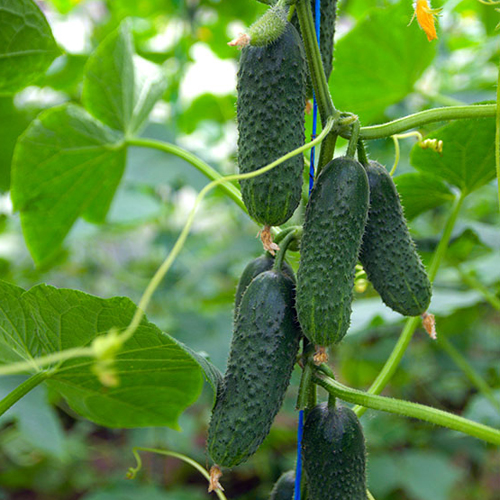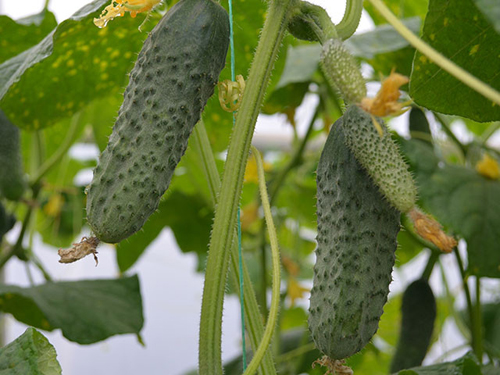Cucumber variety Tumi (F1)
Every gardener dreams of providing his family with early crispy cucumbers and even making money on a fresh vitamin product, from a beginner to learn the wisdom of growing this delicate vegetable to an experienced vegetable grower. Just by the way, a new Tumi variety appeared on the seed market, which is intended for obtaining early production. The application for registration of the novelty in 2013 was submitted by the Dutch company Enza Zaden Beheer B.V. Two years later, in 2015, the variety was entered into the State Register of Breeding Achievements of Russia with admission in all regions of the country. Recommended for growing in glass and film greenhouses of personal subsidiary plots. It is used for cultivation in spring, summer and autumn. The cucumber is a hybrid, so it is always labeled F1.

Description
The plant is indeterminate, vigorous, more than 2 meters high, medium-branched. The internodes are compact, which is the key to good yields. The open type of bush makes it easier to care for the plant and harvest. The flowering type of the variety is female. In each leaf sinus, mainly 2, sometimes 3 female flowers are formed. The leaves are small, angular-heart-shaped, with a wide-wavy edge, slightly wrinkled, dark green in color.
Tumi fruits have an attractive appearance, small size, and resemble a cylinder in shape. The length of the greenery is 10 - 12 cm. The skin of the cucumber is dense, tender, elastic, dark green in color, light stripes are very short. The surface along the entire length is densely covered with large tubercles, the spines are large. The pulp is white-green in color, good consistency, tender, juicy, crunchy, without bitterness. There are no voids inside the greenery. The taste is excellent. Seeds in the stage of milky ripeness are practically not felt. The mass of greenery according to the State Register is 96 grams. The originator claims 80 - 110 grams.
Variety characteristics
- Tumi's hybrid provides an early harvest of standard gherkins. From the moment of emergence of full shoots to the beginning of fruiting, 38 - 40 days pass. Such an early ripening period for cucumbers will allow the use of the crop in an extended circulation, which is very valuable for industrial cultivation;
- marketable yield was 13.0 kg per 1 square meter;
- even during the period of low temperatures, our hero shows excellent growth and development. Forms fruit and does not shed the ovary in stressful conditions. Lack of lighting does not affect the plant;

- the culture has powerful immunity. Cucumber is resistant to olive spot virus, powdery mildew and cucumber mosaic virus. Thanks to this, the variety can be successfully cultivated even in the open field;
- Tumi fruits do not outgrow, do not barrel, retain their weight and proportions;
- the variety belongs to parthenocarpic, therefore it is so popular in the greenhouse industry. The crop is formed and developed despite the absence of pollinating insects and poor weather conditions;
- transportability and keeping quality are high. The harvest perfectly tolerates long-term transportation, and compliance with the storage rules prolongs the consumption of the cucumber;
- the way of use is universal. Fresh cucumbers are great in salads. Due to their dense structure and small size, they are excellent for canning. They have high salting qualities.
Agrotechnics
Tumi shows the best results when grown in seedlings. For cultivation in summer circulation, seeds are sown in April. After about 22 days, the cucumber seedlings are ready for transplantation to a permanent place in the greenhouse, by which time they should have at least 3 true leaves. To use the variety in spring or autumn rotation, the sowing time is shifted. The crop has a strong root system, but prefers a well-drained and fertile soil. Grows well on treated and fertilized loams. The recommended planting density is about 3 plants per square meter. The plant must be tied to a trellis and formed into one stem, removing the growing lateral shoots.In the greenhouse, you need to control the humidity level and try to keep the temperature within 25 ° C. For the rest, caring for the variety is no different from the generally accepted one. If you cultivate a vegetable in the southern regions, then caring for it is simplified due to the ability to abandon the garter in favor of the usual method of spreading. A cucumber is planted in an area with scattered penumbra so that the foliage does not burn.
The Tumi hybrid is intended for cultivation in greenhouses, has an early ripening period and has a high parthenocarp, which means it is suitable for extended circulation. From one plant, you can harvest an excellent harvest of pickles and gherkins, which have high salting qualities. The combination of characteristics such as resistance to disease and rapid recovery from an unfavorable period increases the demand for the variety among farmers who grow vegetables for sale. Our hero is still very young, but during their acquaintance with him, the gardeners did not reveal significant drawbacks, except for the need to tie up and form a plant. In addition, seed material will have to be purchased annually, since it will not be possible to collect cucumber seeds on your own.








